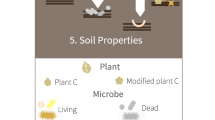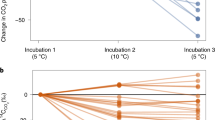Abstract
It has been suggested that increases in temperature can accelerate the decomposition of organic carbon contained in forest mineral soil (Cs), and, therefore, that global warming should increase the release of soil organic carbon to the atmosphere1,2,3,4,5,6. These predictions assume, however, that decay constants can be accurately derived from short-term laboratory incubations of soil or that in situ incubations of fresh litter accurately represent the temperature sensitivity of Cs decomposition. But our limited understanding of the biophysical factors that control Cs decomposition rates, and observations of only minor increases in Cs decomposition rate with temperature in longer-term forest soil heating experiments7,8,9,10,11,12 and in latitudinal comparisons of Cs decomposition rates13,14,15 bring these predictions into question. Here we have compiled Cs decomposition data from 82 sites on five continents. We found that Cs decomposition rates were remarkably constant across a global-scale gradient in mean annual temperature. These data suggest that Cs decomposition rates for forest soils are not controlled by temperature limitations to microbial activity, and that increased temperature alone will not stimulate the decomposition of forest-derived carbon in mineral soil.
This is a preview of subscription content, access via your institution
Access options
Subscribe to this journal
Receive 51 print issues and online access
$199.00 per year
only $3.90 per issue
Buy this article
- Purchase on Springer Link
- Instant access to full article PDF
Prices may be subject to local taxes which are calculated during checkout



Similar content being viewed by others
References
Schimel,D. S. et al. Climatic, edaphic, and biotic controls over storage and turnover of carbon in soils. Glob. Biogeochem. Cycles 8, 279–293 (1994).
Trumbore,S. E., Chadwick,O. & Amundson, A. Rapid exchange between soil carbon and atmospheric carbon dioxide driven by temperature change. Science 272, 393–396 (1996).
Kirschbaum,M. U. F. The temperature dependence of soil organic matter decomposition, and the effect of global warming on soil organic C storage. Soil Biol. Biochem. 27, 753–760 ( 1995).
VEMAP members. Vegetation/ecosystem modeling and analysis project: Comparing biogeography and biogeochemistry models in a continental-scale study of terrestrial ecosystem response to climate change and CO2 doubling. Glob. Biogeochem. Cycles 9, 407–437 (1995).
Cao,M. & Woodward,F. I. Dynamic responses of terrestrial ecosystem carbon cycling to global climate change. Nature 393, 249–252 (1998).
Jenkinson,D. S., Adams,D. E. & Wild,A. Model estimates of CO2 emissions from soil in response to global warming. Nature 351, 304–306 (1991).
Nadelhoffer,K. J., Giblin,A. E., Shaver,G. R. & Laundre,J. A. Effects of temperature and substrate quality on element mineralization in six arctic soils. Ecology 72, 242– 253 (1991).
Peterjohn,W. T., Melillo,J. M., Bowles,F. P. & Steudler,P. A. Soil warming and trace gas fluxes: experimental design and preliminary flux results. Oecologia 93, 18– 24 (1993).
Townsend,A. R., Vitousek,P. M., Desmarais, D. J. & Tharpe,A. Soil carbon pool structure and temperature sensitivity inferred using CO 2 and 13CO2 incubation fluxes from five Hawaiian soils. Biogeochemistry 38, 1– 17 (1997).
Winkler,J. P., Cherry,R. S. & Schlesinger, W. H. The Q10 relationship of microbial respiration in a temperate forest soil. Soil Biol. Biochem. 28, 1067–1072 (1996).
Updegraff,K., Pastor,J., Bridgham,S. D. & Johnston,C. A. Environmental and substrate controls over carbon and nitrogen mineralization in northern wetlands. Ecol. Applic. 5, 151 –163 (1995).
Holland,E. A., Townsend,A. R. & Vitousek, P. M. Variability in temperature regulation of CO 2 fluxes and N mineralization from five Hawaiian soils: implications for a changing climate. Glob. Change Biol. 1, 115–123 (1995).
Liski,J., Livesniemi,H., Maketa,A. & Westman,C. CO2 emissions from soil in response to climate warming are over-estimated—The decomposition of old soil organic matter is tolerant of temperature. Ambio 28, 171–174 ( 1999).
Feller,C. & Beare,M. H. Physical control of soil organic matter dynamics in the tropics. Geoderma 79, 69–116 (1997).
Gregorich,E. G., Ellert,B. H. & Monreal, C. M. Turnover of soil organic matter and storage of corn residue C estimated from C-13 abundance. Can. J. Soil Sci. 75, 161–167 (1995).
Bashkin,M. & Binkley,D. Changes in soil carbon following afforestation in Hawaii. Ecology 79, 828 –833 (1998).
Motavalli,P. P. et al. Comparison of laboratory and modeling simulation methods for estimating soil carbon pools in tropical forest soils. Soil Biol. Biochem. 26, 935–944 ( 1994).
Hart,S. C., Nason,G. E., Myrold,D. D. & Perry,D. A. Dynamics of gross nitrogen transformations in an old-growth forest: the carbon connection. Ecology 75, 880– 891 (1994).
Trumbore,S. E. et al. Belowground cycling of carbon in forests and pastures of Eastern Amazonia. Glob. Biogeochem. Cycles 9, 515 –528 (1995).
Balesdent,J., Mariotti,A. & Guillet, B. Natural 13C abundance as a tracer for studies of soil organic matter dynamics. Soil Biol. Biochem. 19, 25–30 (1987).
Paul,E. & Clark,F. Soil Microbiology and Biochemistry (Academic, New York, 1996).
Binkley,D. & Resh,S. C. Rapid changes in soils following Eucalyptus afforestation in Hawaii. Soil Sci. Soc. Am. J. 63, 222–225 (1999).
Veldkamp,E. Organic carbon turnover in three tropical soils under pasture after deforestation. Soil Sci. Soc. Am. J. 58, 175– 180 (1994).
Cheng,W. et al. Is available carbon limiting microbial respiration in the rhizosphere? Soil Biol. Biochem. 28, 1283– 1288 (1996).
Bonde,T., Christensen,B. T. & Cerri, C. C. Dynamics of organic matter as reflected by natural 13C abundance in the particle size fractions of forested and cultivated Oxisols. Soil Biol. Biochem. 24, 275– 277 (1992).
Sørenson,L. H. Carbon-nitrogen relationships during the humification of cellulose in soils containing different amounts of clay. Soil Biol. Biochem. 13, 313–321 (1981).
Mahieu,N., Powlson,D. H. & Randall, W. Statistical analysis of published carbon-13 CPMAS spectra of soil organic matter. Soil Sci. Soc. Am. J. 63, 307–319 (1999).
Post,W. M., Emanuel,W. R., Zinke,P. J. & Stangenberger,A. G. Soil carbon pools and world life zones. Nature 298, 156–159 (1982).
Goulden,M. L. et al. Sensitivity of boreal forest carbon balance to soil thaw. Science 279, 214–217 (1998).
Townsend,A. R., Vitousek,P. M. & Trumbore, S. E. Soil organic matter dynamics along gradients in temperature and land use on the Island of Hawaii. Ecology 76, 721–733 (1995).
Acknowledgements
We thank R. Hubbard, D. Binkley, R. Waring, S. Hart, S. Trumbore, I. Døckersmith, R. Sanford Jr and M. Bashkin for comments on earlier versions of this manuscript, and R. King for help with statistics. This work was supported by the US National Science Foundation and the USDA Forest Service.
Author information
Authors and Affiliations
Corresponding author
Rights and permissions
About this article
Cite this article
Giardina, C., Ryan, M. Evidence that decomposition rates of organic carbon in mineral soil do not vary with temperature. Nature 404, 858–861 (2000). https://doi.org/10.1038/35009076
Received:
Accepted:
Issue Date:
DOI: https://doi.org/10.1038/35009076
This article is cited by
-
The spatial response of carbon storage to territorial space composition and landscape pattern changes: A case study of the Fujian Delta urban agglomeration, China
Environmental Science and Pollution Research (2024)
-
Analysis of the driving role and impact of road construction on carbon stock
Environmental Science and Pollution Research (2023)
-
Spatiotemporal dynamics of forest ecosystem carbon budget in Guizhou: customisation and application of the CBM-CFS3 model for China
Carbon Balance and Management (2022)
-
Ecosystem productivity has a stronger influence than soil age on surface soil carbon storage across global biomes
Communications Earth & Environment (2022)
-
Global apparent temperature sensitivity of terrestrial carbon turnover modulated by hydrometeorological factors
Nature Geoscience (2022)
Comments
By submitting a comment you agree to abide by our Terms and Community Guidelines. If you find something abusive or that does not comply with our terms or guidelines please flag it as inappropriate.



